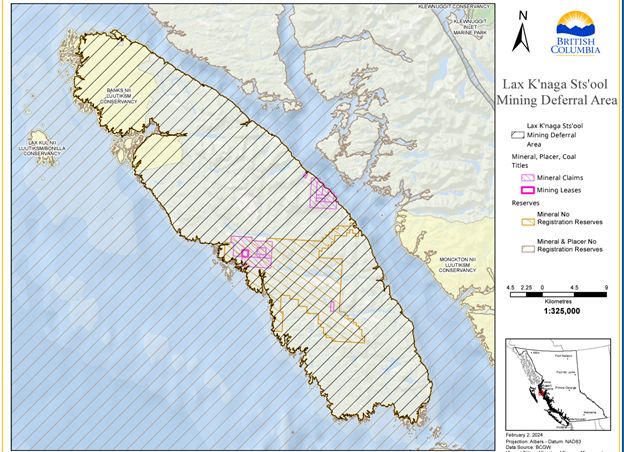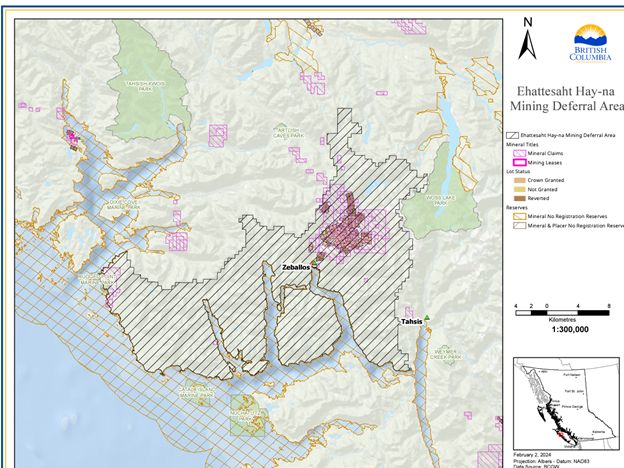On March 7, 2024, the Province of British Columbia released interim measures in response to the BC Supreme Court's ruling in Gitxaala v. British Columbia (Chief Gold Commissioner), 2023 BCSC 1680. The Province has suspended mining activities in the asserted traditional territories of Gitxaala Nation and Ehattesaht First Nation until 2029 and has indefinitely suspended the registration of new mineral claims in these areas.
Background
Following the release of the Gitxaala decision, we published an in-depth analysis of its importance. As part of its decision, the Court declined to reverse (or "quash") existing mineral claims in the asserted traditional territories. The Court also granted the Province 18 months to modify its system of granting mineral tenures to account for Indigenous consultation prior to the grant of claims. During the interim 18-month period, the Court permitted ongoing mineral exploration work and the registration of new mineral claims.
The BCSC also ruled that the UN Declaration on the Rights of Indigenous Peoples ("UNDRIP") was not made enforceable as law in British Columbia. It also ruled that Indigenous Nations cannot challenge laws in British Columbia on the basis that they are "inconsistent" with the UN Declaration.
Both Gitxaala and Ehattesaht have filed Notices of Appeals to the BC Court of Appeal.
What Are the Interim Measures?
In response to the pending appeals, the Province has implemented interim measures, in the form of four Orders in Council ("OIC") (links to the OICs 110, 111, 112, and 113). The combined effect of the OICs is to temporarily halt any mineral exploration or development work in designated areas, which comprise large portions of Gitxaala and Ehattesaht's respective traditional territories (maps below).
The four OICs implement the following interim measures:
- Designate areas where there is no permitted registration of new mineral claims, placer claims, or mineral leases. This is accomplished by preventing the registration of any claims in the designated areas indefinitely;
- Designate areas ("Deferral Areas") where (until
February 21, 2029) no "mining activities" may be
undertaken (other than reclamation work) by the following
individuals:
- registered mineral claim holders,
- registered mineral lease holders in the Deferral Areas,
- 2-post Crown grant claim holders, and
- free miners without a registered mineral claim.
- No new permits may be issued under the Mines Act in the Deferral Areas.
- The expiration deadlines of existing tenures are extended until after February 21, 2029.
- If Gitxaala or Ehattesaht consent to specific exploration activities during the interim period, exploration activities may proceed.
The term "mining activity" is broadly defined and means "any activity related to the exploration and development of a mineral".
What Is Next for the Appeal?
As of the time of publication, Gitxaala and Ehattesaht both will continue their challenges to the mineral tenure regime in appeals to the BC Court of Appeal.
Gitxaala seeks a declaration that the Provincial Crown's system for granting mineral titles through the combined operation of the Mineral Tenure Act, the Mineral Tenure Act Regulation, and the Mineral Titles Online Registry, taken together, is not consistent with the UN Declaration on the Rights of Indigenous Peoples. Gitxaala also seeks to establish that the Provincial Crown has a statutory duty to consult and cooperate with Gitxaala concerning measures necessary to ensure the mineral tenure regime is consistent with UNDRIP.
Ehattesaht and Gitxaala also seek declarations from the Court of Appeal that UNDRIP is incorporated into the laws of British Columbia and that Declaration on the Rights of Indigenous Peoples Act action plan ("DRIPA") permits the courts to determine whether a law in British Columbia is consistent with UNDRIP.
On March 7, 2024 the Province also announced that in March 2024, it will commence "engagement" with stakeholders and industry, and "consultation and cooperation" with Indigenous Nations regarding modernization of the existing mineral tenure regime. The Province has already been undertaking work with First Nations leadership in British Columbia regarding modernization, consistent with its commitments under the DRIPA Action Plan. There are few details on extent of engagement, consultation or cooperation that will occur.
Gitxaala Deferral Area ("Lax K'naga Sts'ool")

Ehattesaht Deferral Area ("Ehattesaht Hay-na")

The content of this article is intended to provide a general guide to the subject matter. Specialist advice should be sought about your specific circumstances.


